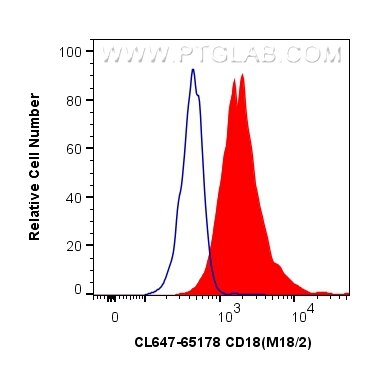CD18 Monoklonaler Antikörper
CD18 Monoklonal Antikörper für FC
Wirt / Isotyp
Ratte / IgG2a, kappa
Getestete Reaktivität
Maus
Anwendung
FC
Konjugation
CoraLite® Plus 647 Fluorescent Dye
CloneNo.
M18/2
Kat-Nr. : CL647-65178
Synonyme
Galerie der Validierungsdaten
Geprüfte Anwendungen
| Erfolgreiche Detektion in FC | Maus-Splenozyten |
Empfohlene Verdünnung
| Anwendung | Verdünnung |
|---|---|
| This reagent has been tested for flow cytometric analysis. It is recommended that this reagent should be titrated in each testing system to obtain optimal results. | |
| Sample-dependent, check data in validation data gallery | |
Produktinformation
CL647-65178 bindet in FC CD18 und zeigt Reaktivität mit Maus
| Getestete Reaktivität | Maus |
| Wirt / Isotyp | Ratte / IgG2a, kappa |
| Klonalität | Monoklonal |
| Typ | Antikörper |
| Immunogen | Maus-CTL-Glykoprotein |
| Vollständiger Name | integrin beta 2 |
| GenBank-Zugangsnummer | BC145644 |
| Gene symbol | Itgb2 |
| Gene ID (NCBI) | 16414 |
| Konjugation | CoraLite® Plus 647 Fluorescent Dye |
| Excitation/Emission maxima wavelengths | 654 nm / 674 nm |
| Form | Liquid |
| Reinigungsmethode | Mit Protein-A-Affinitätschromatographie gereinigt |
| Lagerungspuffer | PBS with 0.1% sodium azide and 0.5% BSA. |
| Lagerungsbedingungen | Store at 2-8°C. Avoid exposure to light. Stable for one year after shipment. 20ul Größen enthalten 0,1% BSA. |
Hintergrundinformationen
CD18, also known as integrin beta-2, is a transmembrane protein that forms heterodimers with CD11a, CD11b, CD11c, CD11d (PMID: 1968349). CD11a/CD18 (LFA-1) is expressed by all leukocytes, while CD11b/CD18 (Mac-1) and CD11c/CD18 (p150,95) are normally restricted to expression on monocytes, macrophages, polymorphonuclear lymphocytes (PMNs), and natural killer cells (PMID: 1968349; 3109455; 10946284). CD18 plays an important role in mediating cell adhesion during immune response and defects of CD18 cause leukocyte adhesion deficiency (PMID: 3594570).
Protokolle
| Produktspezifische Protokolle | |
|---|---|
| FC protocol for CL Plus 647 CD18 antibody CL647-65178 | Protokoll herunterladen |
| Standard-Protokolle | |
|---|---|
| Klicken Sie hier, um unsere Standardprotokolle anzuzeigen |


